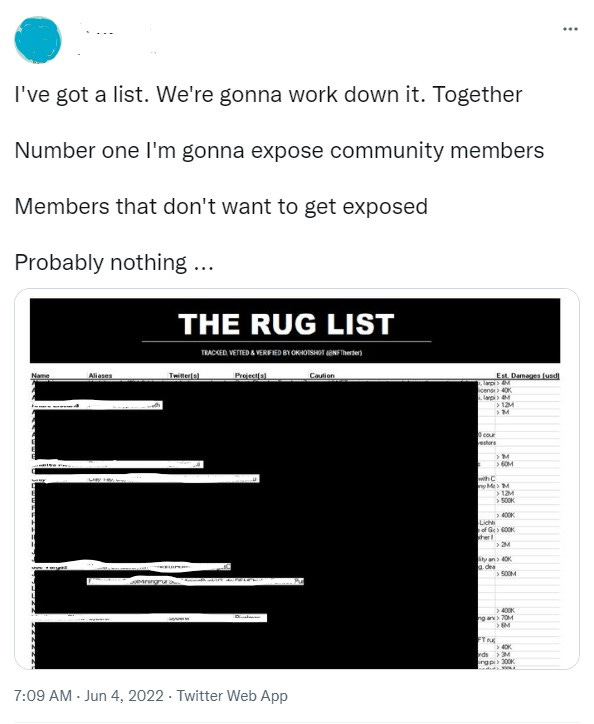Owning Up to the Ownership Economy
Part 1 - Identifying a problem, and starting towards a solution.
Where to Begin
As someone who has moved from the casual observer, to cautiously optimistic, to slowly carving out a future for himself in the web3 space over the last few years, I am invested in the long-term success of this industry. As such, recent events, market trends, and certain “open letters” have not surprisingly elicited some reflection on the ecosystem, its trajectory, and my place in it. I’m guessing I’m not the only one in this position, so the question is, where to start? As a self-proclaimed “reasonably prudent student”, it behooves me to address the recent open letter to Congress written and signed by 26 people of varying degrees of technological expertise (and questionable argumentative prowess). As for a line-by-line “call and response” breakdown of the letter, I’ll leave that to those who are much more qualified than I. Preston Byrne gives a particularly pointed refutation of the letter on his personal website if you’re interested in going down that rabbit hole. While I am still of the opinion that the aforementioned letter is mostly self-aggrandizing bloviation, lacking as much intellectual honesty in its conclusory claims as it is in cited references, that doesn’t mean it isn’t reflective of an entrenched social perception of web3, or that it isn’t indicative of the need to honestly investigate why this perception exists. As with any important investigation, we must start by asking the right questions, so let’s start with why.
The Why
Unless you’ve been living under a rock, buried deep in a cave, overgrown by dense jungle, while in a coma, you’re probably aware that things are not great in the wild world of web3 at the moment. The last six months or so have seen an onslaught of downward momentum, rugs, scams, and instability. Eth and Bitcoin are down ~55-60% from their respective ATHs; DeFi platform’s have lost approximately $1.8 Billion to exploits just in the first quarter of 2022; losses from NFT hacks increased almost 700% so far this year; not to mention the collapse of the Terra ecosystem which lost investors of all shapes and sizes upwards of $60 Billion in a matter of days. And this is just the tip of a complex and interconnected iceberg. The market effects resulting from rising inflation, external political factors, and ongoing regulatory/litigatory uncertainty are not helping the situation by any stretch of the imagination. Poorly cited letters to Congress aside, observations and predictions from within the web3 space seem to get increasingly dire by the day. Even the most cursory stroll through crypto Twitter leads one to accounts created specifically to track rug pulls and hacks, lengthy threads on the various celebrities and influencers scamming communities of fans (Repeatedly I might add), and people publicly doxing alleged anon scammers (pic below redacted because I could not verify these claims).
While it is important to honestly assess the negative aspects of this space (more on that in just a bit), it’s also important to put things into perspective. According to a report by the Retail Industry Leaders Association, approximately “$68 billion worth of products were stolen from retailers in 2019”. The next statistic in that report states that overall retail crime “results in $125.7 billion in lost economic activity” every year. Shifting over to the digital world, 2021 saw a combined loss of $56 billion to identity fraud. Furthermore, the FTC reports an additional $5.8 billion lost to online shopping and “imposter scams” (sound familiar NFT degens?). So, if all this is just the way the world works, and “scammers gonna scam” regardless of where we decide to put our money and resources, does that mean web3 is off the hook? I say no.
The crypto community was built largely on the premise, and dare I say promise, of fixing many of the problems that it has seemingly opened the floodgates to (See web3 doom and gloom stats above). This is precisely why we should be asking ourselves some hard questions about the current state of the industry, our shared and individual incentives, and what we want out of this space moving forward. Looking at the trends and commentary, we likely are heading into, or are already at the beginning of what many are calling another “crypto winter”. While this may or may not be as bad as some analysts predict, one readily apparent thing is the general consensus that web3 is down bad. And while it is uncertain when or how things will begin to turn back around, it is important that we take some time to reflect on what went wrong and what we’re going to do about it.
So, What?
So, what SHOULD we do about it then? Saunter back to our cozy dens of complacency, settle in, and wait out the forthcoming crypto winter with the rest of the bears? Or do we get to work preparing for success in the spring? As an old, cranky, chain-smoking supervisor of mine used to say “bringing up problems without offering solutions is just whining”. And while he used much more expletive-laden language when providing this nugget of inspirational wisdom, the general principle has always stuck with me and is one I see echoed by others in this space:



In an attempt to be part of the solution and not just another amplifier of our problems, I’m proposing a community audit of the web3 space that focuses on a risk vs. reward analysis for the average user/consumer, highlights solutions already in place, and proposes any solutions that can be readily implemented.
And How
In my 10+ years working in the web2 world, most of which were spent at a large online retailer we’ll call schmamazon in the spirit of anonymity, one of the most valuable skills I learned was how to work backward from a problem, identifying the needs that are not being met, and systematically building solutions to fill in those gaps. For me, this process starts with asking simple questions and being open to tough answers that might challenge assumptions and long-held beliefs about something I thought I understood. This is the process I will use to kick off my analysis into the strengths of web3 that provide a measurable benefit to consumers, as well as the risks involved, and the best practices when it comes to mitigation of said risks.
In the spirit of community, am inviting and encouraging anybody interested in joining me, to participate and contribute to this analysis. Below is a link to a google form you can use to provide your input and feedback on the following questions (all responses will remain anonymous):
What do you think web3 does well/not so well?
What are some of the biggest risk factors of/protections offered by web3?
What changes in technology would you like to see in this space?
What changes in community/culture would you like to see in this space?
What projects or initiatives are addressing important questions and/or building the necessary solutions in the web3 space already?
What other questions do you think are important to ask for this analysis?
I will be using this input and feedback in tandem with my personal research to guide and accompany any findings and/or proposals that come out of this analysis. I sincerely wish I had some answers to provide at the end of this pithy little call to action, unfortunately, all I have are more questions for you. Hopefully, the next installment will be able to provide some more educated insight, or at a minimum highlight existing solutions that seem to be working. For the time being, however, I’ll offer one perspective on the state of web3 from someone in the space who has rightly earned at least thoughtful consideration of his opinions.

Thank you.
Chris







